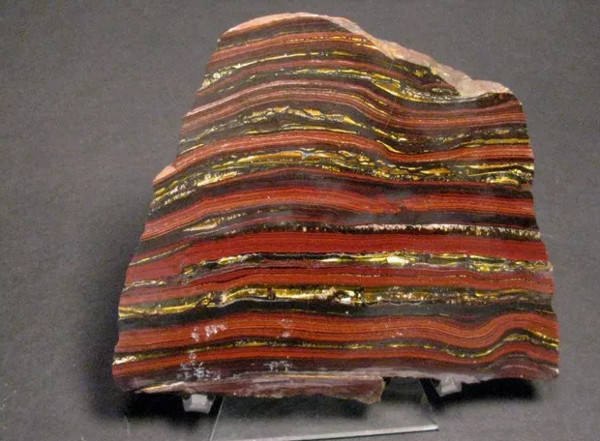How does oxygen on Earth come from?
Not everyone knows when the origin of the third most common element in the universe appeared on Earth.
Learn about oxygen on Earth
Oxygen is the most important factor for human survival as well as many other organisms on Earth, only 5 minutes of oxygen deprivation of brain tissue is permanently irreversible. However, not everyone knows when the origin of the common element ranked third in this universe appeared. Let's find out with us.

Oxygen is the most important factor for human survival.
The first half of Earth's history - about 2 billion years - has absolutely no oxygen, but that doesn't mean there's no life. There is still a lot of controversy with the main biological elements in the 'oxygen money' world and researchers are looking for clues from the oldest sedimentary rocks on our planet.
Most scientists believe that the amount of oxygen in the atmosphere is negligible until 2.4 billion years ago, when the Great Oxygenation Event (GOE) occurred. The jump in oxygen concentration is mainly caused by cyanobacteria , also known as blue algae - the photosynthetic bacteria that breathe oxygen . When and how this oxygen-producing bacterium appears is unknown, due to the fact that the GOE event is the intersection of global freezing, mineral volatility and the abundance of new species.
Dr Dominic Papineau of the Carnegie Institution of Washington, said: 'We don't know what the cause is and what the consequences are. Some events happen at the same time, so the story is still unclear . ' To help resolve this geographic question, Papineau is studying banded iron formations (BIFs) , sedimentary rocks formed at the bottom of ancient seas. Papineau's research, funded by NASA's Evolutionary Biology Program, focuses on certain minerals within BIFs that may be closely related to the life (and death) of bacteria since ancient times. .

Photographs of iron specimens create a sequence at the Australian Natural History Museum.
Iron minerals in BIFs are the largest source of iron ore in the world. However, these stones are much more valuable than steel. Geographers exploit them because of rich historical records that last from 3.8 billion to 0.8 billion years ago. However, the oldest source of BIF is still a mystery. Scientists think that they need the help of organisms to be able to form, but which organisms? The unicellular marine animals do not leave bones or shells so we can find out, but Papineau thinks that there may still be minerals or fossilized localization in BIFs.
He discovered carbon materials in BIFs related to apatite, a phosphate mineral often associated with biology. This means that what constitutes BIF is still in their own products. To test this, Papineau's team will study carbon in BIF and compare it with other non-biological carbon minerals, including minerals found in a Martian meteorite.
In addition, Professor Andreas Kappler of the University of Tuebingen in Germany, who is also interested in the study, said: ' This research has the potential to prove that bacterial biomass is linked and deposited with iron minerals' . It is possible that the bacteria that make up BIF are cyanobacteria, because the oxygen from these bacteria causes iron to oxidize in the seas before the GOE event. But if the cyanobacteria appeared long before the GOE, why does it take hundreds of millions of years for the oxygen they breathe to accumulate in the atmosphere?

Professor Andreas Kappler.
Papineau and colleagues may have found part of the answer in the complex context of biology and geography. Oxygen from cyanobacteria may have been destroyed due to methane's superiority. These two gases react with each other to produce carbon dioxide and water. Papineau explains: 'Oxygen cannot accumulate in methane-rich environments'.
Methane is thought to originate from bacteria called methanogens , which release methane after consuming carbon dioxide and hydrogen. In this case, methanogen and cyanobacteria share ancient waters, but methanogens dominate - their methane release inhibits oxygen, and warms the planet through the greenhouse effect. However, until the time of GOE, these organisms began to disappear, and oxygen from cyanobacteria filled the atmosphere was exhausted of methane.
Linking the GOE event with the decline of methanogen has been mentioned before, but there is little evidence to support a hypothesis that the loss of nickel within BIFs is the cause of this problem. . Recently, however, Papineau and colleagues reported in Nature that the concentration of nickel in BIFs dropped significantly by 2.7 billion years ago. Sea level of nickel decreased by 50% just before GOE occurred. This is important because methanogens depend on nickel: it is the central material for metabolic enzymes involved in methane formation. When the concentration of nickel decreases, methanogens are "hungry" and they will disappear over time.

Image of methanogen bacteria through electron microscope.
The Nikel scarcity situation makes the pre-GOE development of cyanobacteria more plausible, but more evidence is needed to confirm this.Kappler believes that studying the origin of the oldest BIFs can tell us when life begins to develop the ability to breathe oxygen and thus change the world forever.
Oxygen was discovered by Swedish pharmacist Carl Wilhelm Scheele in 1772 by heating copper oxide and a few nitrate salts. Scheele called oxygen "burnt gas" because it was the only gas that supported the fire discovered at the time. He wrote a report on this discovery in a manuscript entitled Treatise on Air and Fire, then sent to the publisher in 1775. This document was later published in 1777. Username The elemental element of oxygen is octium.
Free oxygen is virtually non-existent in the Earth's atmosphere before ancient archaea bacteria evolved about 3.5 billion years ago. Free oxygen first appeared in large quantities throughout the paleontology (between 3.0 and 2.3 billion years ago). For the first 1 billion years, any form of free oxygen produced by these organisms combined with dissolved iron in the oceans to form the iron layers that form the sequence. When this oxygen sank, it became saturated, free oxygen began to escape in the form of gas from the ocean 2.7 billion years ago, reaching 10% of the current level of about 1.7 billion years ago.
The presence of large amounts of dissolved oxygen and free oxygen in the oceans and in the atmosphere may have prompted anaerobic organisms that are living on the brink of extinction throughout the disaster of about 2.4 hours ago. billion years. However, cellular respiration using oxygen allows aerobic organisms to produce more molecules that carry ATP energy than anaerobic organisms, which makes aerobic organisms predominate in the Earth's biosphere.
From the beginning of the Cambrian period 540 million years ago, oxygen function fluctuated between 15% and 30% by volume. At the end of the Carbon century (300 million years ago) the atmospheric oxygen level reached its maximum value, accounting for 35% of the volume, which contributed to the large size of insects and amphibians at the time. Human activities such as burning 7 billion tons of fossil fuels each year have little effect on the oxygen content of the atmosphere.At the current rate of photosynthesis, it may take about 2,000 years to create all the oxygen in the current atmosphere.
- Video: What happens if the Earth loses oxygen in 5 seconds?
- Oxygen appeared early on Earth
- What happens if we breathe twice as much oxygen now?
- Interesting secrets about oxygen
- The new clue of oxygen isotope originates the solar system
- The amount of oxygen in the Earth's atmosphere has lost 0.7% without knowing why
- Unexpected discovery: The solar wind winds oxygen on Earth to the moon
- Most creatures on Earth disappeared 2 billion years ago
- Detection of 2.5-billion-year-old fossil microbes live without oxygen
- Oxygen gas exists when humans have not yet appeared
- Methanobacterium - Gas source in the bottom of the water
- Where does the oxygen for the oxygen mask really come from?
 'Fine laughs' - Scary and painful torture in ancient times
'Fine laughs' - Scary and painful torture in ancient times The sequence of numbers 142857 of the Egyptian pyramids is known as the strangest number in the world - Why?
The sequence of numbers 142857 of the Egyptian pyramids is known as the strangest number in the world - Why? History of the iron
History of the iron What is alum?
What is alum?